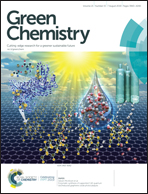Base-free conversion of glycerol to methyl lactate using a multifunctional catalytic system consisting of Au–Pd nanoparticles on carbon nanotubes and Sn-MCM-41-XS†
Abstract
Multifunctional catalytic systems consisting of physical mixtures of (i) bimetallic Au–Pd nanoparticles (average size of 3–5 nm) supported on functionalised carbon nanotubes (CNTs) and (ii) Sn-MCM-41 nanoparticles (50–120 nm), were synthesised and investigated for the base-free, selective conversion of glycerol to methyl lactate in a batch reactor. The catalysts were characterised by means of transmission electron microscopy, N2-physisorption, energy-dispersive X-ray spectroscopy, X-ray photoelectron spectroscopy and by Boehm titration. The catalyst based on bimetallic AuPd/CNTs showed much higher activity than the monometallic Au or Pd counterparts, thus indicating synergetic effects. Functionalisation of the CNTs by oxidative treatments had a positive effect on catalyst performance, which was correlated to the observed increase in surface acidity and hydrophilicity. The highest yield of methyl lactate achieved in this work was 85% at 96% glycerol conversion (140 °C, 10 h at 30 bar air), which is the highest yield ever reported in the literature so far. Insights in the reaction pathway were obtained by monitoring the conversion-time profiles for intermediates and their possible role as inhibitors. Batch recycling experiments demonstrated the excellent reusability of the catalyst.

- This article is part of the themed collection: International Symposium on Green Chemistry 2019


 Please wait while we load your content...
Please wait while we load your content...